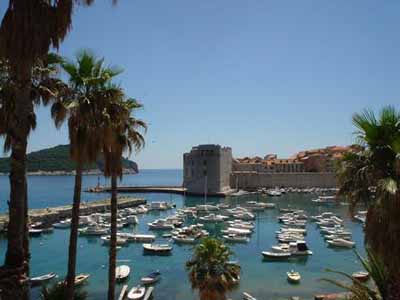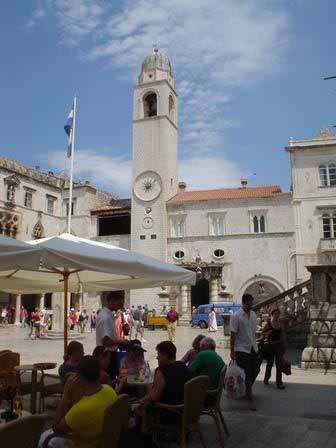Seduced by Dubrovnik
It was mid-afternoon, and the Mediterranean sun was baking the tops of our heads, making it hard to think straight, as we wandered around the labyrinthine streets of the Stari Grad. We had groggily stepped off the Jadrolinija ferry at Gruž harbor in Dubrovnik at noon that day, having spent the previous night partying on the island of Hvar. We had gone directly from the nightclub to our apartment to pick up the luggage, and then on to the ferry at 6:00 a.m. for some much-needed shut-eye.
On arrival, we were ill-prepared for the onslaught of women offering us accommodations “right in Stari Grad, yes, right in the old city of Dubrovnik.” Gathering our wits, we asked to see where the apartments were on the map and managed to weed out the ones that were supposedly “close” to the old city. We were determined to find a place that was actually within the city’s famous fortress walls.

As it turns out, the apartment we ended up being driven to didn’t quite meet our criterion, but it was close enough. It was tucked away at the end of a little alley on a hill directly above the old city, offering us a spectacular view of the city walls, its red-tiled roofs and the Adriatic Sea beyond. It was stunning. Seduced by its beauty, we dropped our bags and dashed off to explore, which is how we found ourselves parched, lost and wandering around Dubrovnik’s polished white-stone pedestrian streets.
It was as we passed the Jesuit church, covered with scaffolding and in the process of restoration, that we first saw the sign, “Cold Drinks and the most beautiful view in the world,” with an arrow pointing around the bend up ahead. If true, it was the best thing we’d heard in years. We followed the staircase, which seemed to hug the 20-meter-high walls of the old fortress. Eventually, we came to a little doorway cut in the stone wall, with another sign that read simply “Cold Drinks.” The offer of “the most beautiful view in the world” had become immediately obvious. The doorway looked directly out onto the bluest sea, far below us and the rocky cliff on which we stood. To the right was a small staircase with a rickety handrail, leading down to a series of small terraces carved into the cliff face, with tables and umbrellas swaying in the gentle breeze. Floating up to us were the strains of an old Frank Sinatra classic, “C’est si bon.” Settling in to our seats with our feet propped up on the balcony railing and the first of several cold Karlovacko beers in hand, we had indeed arrived in Dubrovnik.
There is no better way to spend an entire lazy afternoon than at Café Buža, as we discovered this heavenly spot was called. Flirt with the waiter with your newly acquired Croatian skills as you order another drink—“jedan pivo, molim, hvala”—one beer, please, thank you. That was all you needed to get started. People-watching was another favored activity, whether wondering about the other people at the café or watching the young Croatians on the terraces below. Children were laughing and fearlessly jumping off rocks into the water; girls were sunning themselves and boys were competing for the highest dives. Or merely stare out to sea and let the glinting sunlight on the water mesmerize you until you lose yourself in your own thoughts.

When we finally roused ourselves from this Café Buža-induced trance, it was early evening, so we headed back to our apartment (furnished only in the finest period pieces from late 1970s Yugoslavia) for a quick shower. Easier said than done, since the Stari Grad is shaped like a giant salad bowl ringed by a high wall, meaning that to get from any point to another, you have to go down and then up again. Hard to get used to at first, but makes for a killer set of legs. And legs were on parade when we went out to dinner.
At 8 p.m., everyone was out on the main drag for a stroll and was dressed to the nines. Since it was our first night, we decided to watch and learn. We got an outdoor table at a restaurant on the main square next to the 16th-century Sponza Palace, facing the Venetian baroque Church of St. Blaise, protector of Dubrovnik. As the waiter plied us with Croatian wine and the finest seafood the Mediterranean has to offer, we watched the smart set saunter by. The men were wearing loose, white shirts, open at the neck, and the women wore simple, flattering outfits with cute, color-coordinated accessories in lime green or canary yellow. Our favorite footwear trend was the flat-soled Roman sandal, with leather laces crisscrossed up to the knee.
After a delicious meal, we walked around for a bit, and then discovered a jazz trio playing some old favorites to a crowd in another, smaller square. It was the perfect way to end the day.
The following day was devoted to fun in the sun. First, we headed to a private beach club just east of the old city, where for a few kuna, you get your own lounge chair and umbrella, along with beachside service for food and drinks. After some hard work on our tans, we went for a swim in delicious 21ºC water, although it wasn’t quite the peaceful, idyllic setting we’d encountered at other Croatian beaches. There were far too many other people around, especially rowdy kids. Eventually, we packed up and headed back to Stari Grad for an afternoon gelato and a casual stroll around the city’s sights.
That evening, we headed back to Café Buža, where we struck up an acquaintance with some of the regulars. Thus began our introduction to the wonderful world of travarica, a Croatian liquor made from grapes and flavored with local herbs. Jivjeli, the Croatian word for “cheers” was soon tripping off our tongues as if we’d always known it. At the next table, some local musicians also in for a drink began singing and playing old fishermen’s folk songs. They were laments about husbands who never returned from the sea, or about the bura, the cold winter wind that chills Dubrovnik residents to the bone. It was a reminder that even this paradise has its flipside too.
The next day, in search of better beaches, we took a 20-minute boat ride from the old harbor to the island of Lokrum, just off the coast of Dubrovnik. This was the Adriatic we had come looking for. Lots of little rocky coves, private and secluded, with crystal-clear water and the never-ending sunshine that Dubrovnik enjoys 2,852 hours of each year. After lunch in an old monastery in the center of the island, it was back to more of the same. When we returned to town, we decided on a sunset walk around the top of the old city walls, built between the 8th and 16th centuries. Initially thinking we would pop up there for a quick photo op, we soon found we couldn’t resist walking the entire 1,940-meter circumference, the better to absorb the gorgeous views of the city by the sea from every angle. The city’s motto is Sloboda, or liberty, and with defensive walls this strong, it wasn’t hard to see how Dubrovnik managed to remain the independent Republic of Ragusa for so much of its history.
Energized by another stellar dinner, featuring scorpion fish, a local fish called romb, octopus carpaccio, and black squid risotto, we headed out for an all-nighter at the town’s ital-disco, Fuego. The club featured an entire wall of sparkly lights and a DJ who, miraculously, actually played any song you requested. Escorted by our local friends, we even got in for free.
On our last afternoon in Dubrovnik, we couldn’t resist going back to Café Buža to say farewell to our Ragusan friends. They invited us for a swim, and without further ado, they dove off a rock at the top of the cliff with the word LAV, or lion, spraypainted on it. It looked like fun, but after climbing on top of it and looking a long, long way down into the waves, we decided against it. Some things are better left for next time. Instead, we gingerly descended the staircase cut into the face of the cliff as Croatian kids impatiently scurried past us. Reaching the bottom, we flung ourselves into the deep blue waters of the Adriatic and joined our friends for what would surely not be our last dip in Dubrovnik.
